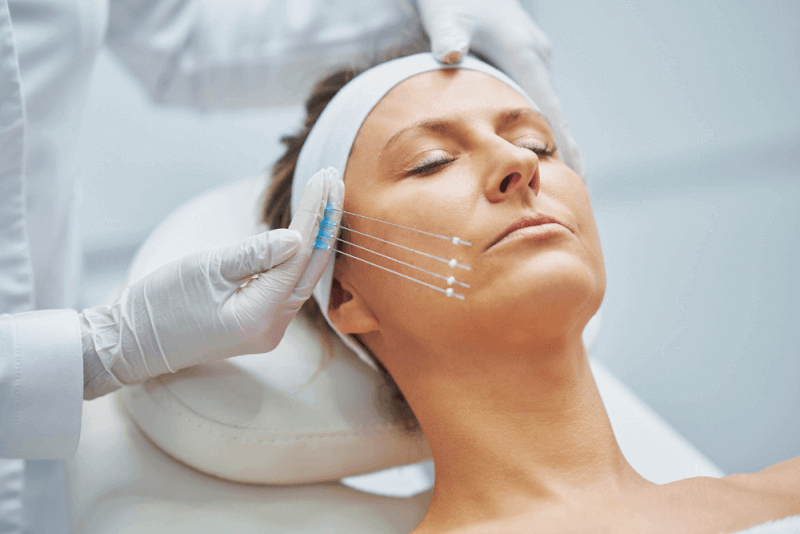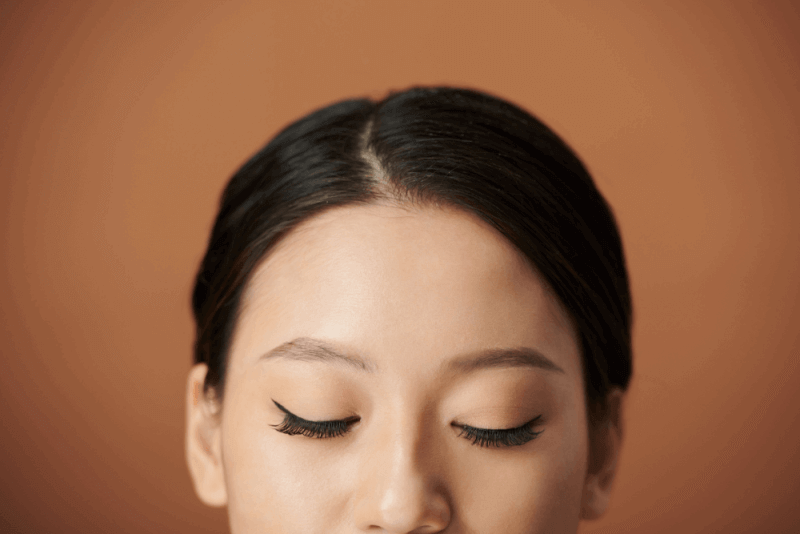What Is a Thread Lift?
The thread lift method, first used in France, is a non-invasive aesthetic procedure that helps lift the skin areas affected by gravity, such as sagging, back into place over time. The internal structure of the threads used in the thread lift method is polyester, while the outer layer is silicone. Due to their flexibility, these threads allow for the necessary interventions to achieve a more youthful appearance. Thread lift is also applied to individuals who have suffered facial paralysis.
How Is a Thread Lift Performed?
The thread lift procedure is performed under local anesthesia. This process, which takes an average of 45 minutes to 1 hour, begins by marking the points where the application will be made. Then, the threads are placed under the skin at these points. Since the attachment point of the thread is inside the head, stitches are not required after the procedure. Any inflammation that may occur after the procedure can be easily managed with painkillers. Individuals can return to their daily routines immediately after the application.
How Does a Thread Lift Work?
The threads used in this method have a barbed system called fishbone, allowing them to adhere to the subcutaneous tissues. This enables the skin to be pulled upwards. The threads are absorbable and dissolve under the skin, so the effects are not immediate.
Why Is a Thread Lift Performed?
Both men and women who are bothered by signs of aging on their skin often choose the thread lift method when they want to change this appearance without surgery. The thread lift helps make the face look younger and more vibrant, and it also helps slow down the aging process.
Additionally, the thread lift technique is used to correct facial asymmetry in individuals who have suffered partial facial paralysis. The threads used in this technique are compatible with human physiology and are very durable, providing long-lasting results.
Common areas where the thread lift method is used include:
- Buttocks
- Cheeks
- Enhancing cheekbones
- Legs
- Sagging under the chin
- Arm sagging
- Contouring the face
- Breast lifting
- Brow lifting
- Neck wrinkles
Where Is a Thread Lift Applied?
Chin
The main goal of using thread lifts in the chin area is to restore the jawline that has become disrupted over time due to sagging. This helps achieve a smooth and oval appearance of the jawline.
Neck
As age progresses, wrinkles in the neck area increase, along with the formation and sagging of a double chin. This leads to a disruption of the neck contours. The thread lift technique is used to correct these issues in the neck area. The threads used for this purpose are made from materials such as polylactic acid and polydioxanone.
Brows
Thread lifts are used in brow lifting procedures to raise brows that have drooped due to aging and to achieve a more aesthetically pleasing appearance. In the thread brow lift method, the threads are anchored to the bone.
Mid-Face
The mid-face is one of the most common areas where thread lifts are applied. Applications in this area produce results similar to a facelift. It is possible to lift the entire face upwards. It is particularly effective in enhancing the cheekbones and achieving a younger appearance.
Nose
In the nose area, thread lifts are used to lift the tip of the nose and correct minor imperfections in the nasal bridge. It also helps adjust the angle between the nose tip and the lip.
Genital Area
When applied to the vagina, a thread lift helps tighten sagging tissues, giving the vagina a firmer and more youthful appearance.
Arms
The thread lift method can also be used to correct sagging in the arms. It is especially effective in non-surgical treatment of sagging in the back of the arms.
Post-Thread Lift Care
The following points should be considered after a thread lift application:
- No pressure should be applied to the skin.
- Resting for a few days after the application is recommended.
- When washing the face, upward movements should be used.
- Jaw movements should be minimized in the first few days after the procedure.
- Avoid sleeping on your face.
- It is recommended to apply ice to the treated area every 2-3 hours after the procedure.
- Do not apply makeup for 24 hours after the procedure.
- Avoid excessive facial and neck movements for 2 weeks.
- Avoid intense exercise, sunlight, dental treatment, and saunas for 2-3 weeks.
- Use the topical medications prescribed after the procedure as directed.
Types of Thread Lifts
There are many different types of threads used in the thread lift method. These threads differ in structure, and their effects and application areas also vary. The types of threads used in the thread lift method include:
Silhouette Soft (Youth Thread Aesthetics)
These threads have cone-shaped notches. They are considered one of the safest thread lifting methods due to the almost zero risk of causing allergies. The notches on the thread allow for the gentle lifting of tissues in the face and neck area.
These threads also increase fibroplastic activation, promoting collagen production. There are three types of these threads: 8, 12, and 16. This allows for the most suitable thread to be chosen depending on the degree of wrinkles and sagging. Applications with these threads take an average of 30-45 minutes, and their effects last between 1.5 to 2 years.
French Lift
The threads used in the French lift can remain under the skin for many years. In addition to being compatible with muscle and fat tissue, they are also highly flexible. This flexibility allows for the correction of issues without affecting facial expressions.
The French lift is performed under local anesthesia. Since the entry point is from the hairline, no scars are left after the procedure. Patients may feel mild pain after the application, which can be controlled with painkillers. Normal life can be resumed immediately after the procedure, and the effects of the French lift can last for up to 5 years. The French lift is also known as the infinity lift.
Aptos Lift
This type of thread is suitable for application during the early stages of aging, providing the best results when sagging is not severe. These threads have barbs facing opposite directions and are made from polypropylene. They are particularly used in the face, neck, brow, and cheek areas, and are made from the same material as non-absorbable surgical sutures. Therefore, they can remain in the applied area for life without causing any reaction.
Local anesthesia is also used for these threads. Anesthesia is applied to both the entry and exit points of the threads. The excess thread at the exit point is cut, and the threads are no longer felt or visible at the exit point. The application takes 1-2 hours, and the threads last for up to 5 years.
Spider Web
After these threads containing PDO material are placed under the skin, they lose 50% of their mechanical lifting ability within 3 months. Over time, they degrade into water and carbonic acid, and after 6 months, they completely dissolve and disappear. However, during the time they remain in place, they promote an increase in fibroblastic activity.
Therefore, the results of the procedure last for 1-1.5 years. The application maximizes skin tightness. The threads support collagen production, increasing skin tone and firmness. Additionally, the formation of new blood vessels in the skin is possible. The threads used in the spider web lift come in different types, such as screw, double spiral, and single.
Who Should Not Undergo a Thread Lift?
Thread lifting is generally suitable for both men and women aged 30 to 65. However, if any of the following conditions are present, the procedure should not be performed:
- Diabetes patients
- Individuals with advanced cancer
- Presence of skin infections
- Individuals with coagulation disorders
- Individuals with severe autoimmune diseases
- Individuals with sensitivity to the materials used
- Pregnant women
Advantages of a Thread Lift
The benefits offered by the thread lift method include:
- Eliminates skin sagging.
- Promotes collagen and elastin production.
- Rejuvenates the skin.







